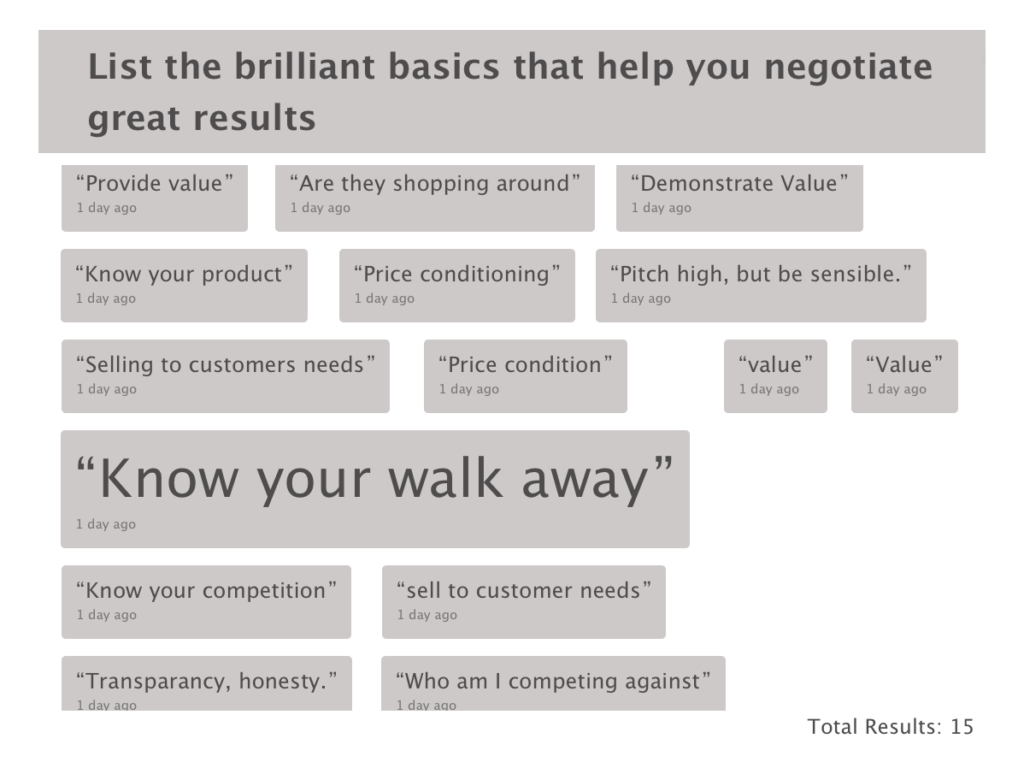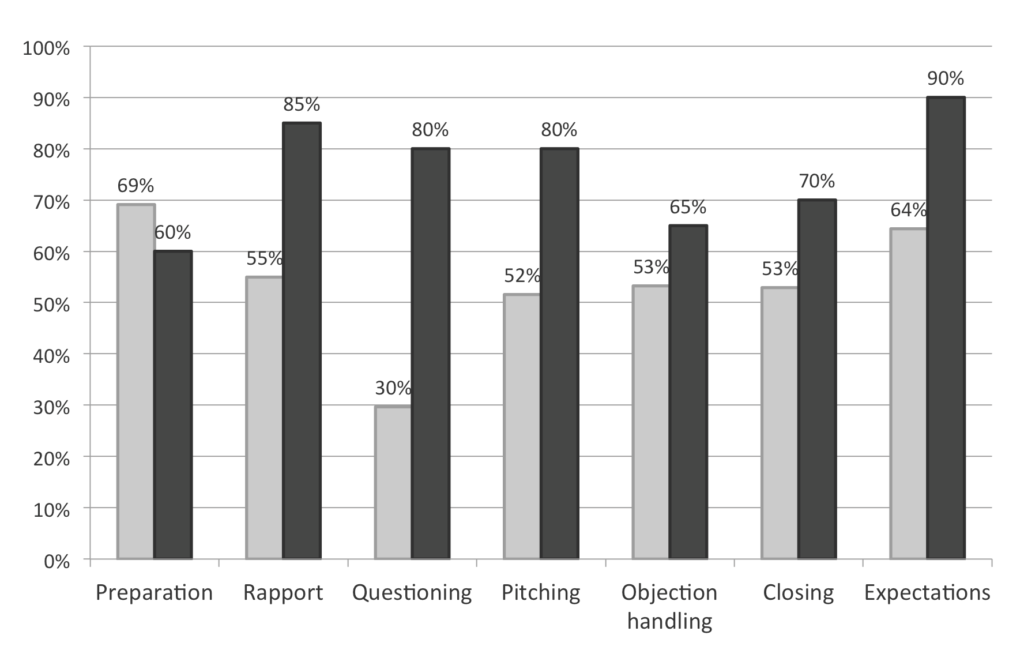Sales training companies provide a niche service to companies by improving their sales effectiveness. Usually the pre-cursor to engaging a sales training company, or sales training provider, is a change in the business environment like these:
1) The inevitable commoditization of the product in the market over time
2) Introduction of new products and services
3) Entrance of a competitor into the market
4) Growth of the business and the need for consistency as the business scales
5) Change of senior sales leadership and sales management
6) Implementation of a CRM
Evaluating Sales Training Companies
Most people start researching this topic by typing, “Sales training companies” into Google. Hundreds, if not thousands of companies and courses come back. So use these 5 questions to quickly narrow down the field:
1) Which audiences does the sales training company focus on?
Within the niche of sales training are further niches, typically these:
1) Business to business – which splits further into
a. Large Corporate
b. Small Medium Enterprise
c. Field sales
d. Internal or Tele sales
2) Business to consumer
3) Channel sales – which again splits into
a. Distributor
b. Value added re-seller
c. Reseller
The reason that this is such an important question is that if the sales training company you are evaluating does not differentiate their programmes along these or similar lines, there will be no match to your sales teams.
2) How does the sales training company build on your successes?
Salestrong have trained over 20,000 sales people worldwide. In all of those interactions there are pockets of best practice and success that can be built on. This saves time and money, and results in a far more successful programme.
Many sales training companies perform a ‘rip and replace’ strategy and deliberately overlook your areas of success for three key reasons:
1. Not in their interest: allowing the client to see that they have pockets of good practice reduces the potential need for their services, so many will not look for best practice.
2. Eating into their profits: most sales training companies have a core ‘sales training methodology’ that they use with all of their clients. For example, Huthwaite uses SPIN, Miller Heiman use Blue Sheets, Franklin Covey use ‘Helping Clients Succeed’. Many vendors can be found on sites like selfgrowth.com. Their materials have the sales training methodology embedded in them. Their faculty are trained in it. Anything that deviates from this core sales training methodology is a cost to them and eats into their profit margins. So absorbing any changes into their methodology will be resisted.
3. Reduces your exit options: the more tools and techniques you use from a sales training vendor, the more sticky you become. This means that you will have to engage them in future interventions as replacing them becomes too painful. And yes you’ve guessed it, the prices go up too!
Salestrong sales training workshops nearly always include a specific exercise to make this the cornerstone of the workshop. We call it the ‘Brilliant Basics’. We ask the delegates for the things that are central to their success, that they already do, and so should be built upon. Here’s an example of a ‘Brilliant Basics’ session recorded in one of our negotiation skills workshops recently:

The workshop participants can input the feedback directly onto the screen using their computers, iPads or phones.
3) How does the sales training company keep the programme alive?
Most sales training companies put the sales audience through a series of classroom interventions in a concentrated timeframe and then hand the ball back to the client.
Sales training companies go for a concentrated period of delivery for a number of reasons. One primary reason is because their faculty trainers are charged out on a day rate. All sales training companies outsource their delivery to independent faculty trainers. They do this because they do not want the faculty on their books when there is no delivery requirement which eats into their profits. Being paid on a day rate, means that it is better for the faculty to be deployed over a concentrated period, rather than say, one day per week over a longer period. The impact on the programme is that there is a concentration of effort followed by a lull. This means that adoption of the sales training methodology in these types of deployments is negligible.
A second reason for a concentrated period of delivery comes back to how they licence their materials. Sales training companies that have a per capita licence structure will want that revenue as soon as possible and that often leads to a ‘sheep dip’ of as many people as soon as possible.
Salestrong sales training programmes have a ‘kick off’ which is staggered period of workshops and communications. We then have a whole year of communications based on insights gleaned from these interactions. We build e-learnings, videos and podcasts that are in tiny bite sized chunk for consuming regularly. Kick off workshops are deliberately two-way. A chance for sales people to improve and a chance for Salestrong to locate and publicise pockets of best practice and insights. Most of the interventions are designed and implemented post ‘kick off’ because the corner stone is what is working well already.
4) How do they bring the customer into the sales training courses?
The most important person in all of my clients’ organisations is the customer. Why do customers therefore have so much difficulty in getting into sales training courses? There are two main reasons:
1) As mentioned above, most sales training companies have a core ‘sales training methodology’ that they use with all of their clients. (SPIN, Blue sheets, ‘Helping Clients Succeed’ etc.). Their materials have the sales training methodology embedded in them. Their faculty are trained in it. Anything that deviates from this core sales training methodology is a cost to them and eats into their profit margins. So absorbing your customer into their methodology will be resisted.
2) Most sales companies were set up in the 1980s when sales training was in it’s hey day. Their technology capability is still in the 1980s and so they struggle to cost effectively capture customer insights in a scalable way.
Here’s an example of how Salestrong bring the customer into the classroom.
5) Do they provide sales coaching support?
Coaching is probably the best way to re-inforce the programme over time. It improves awareness in the coachees and introduces an increased level of accountability in the workplace that is required for people to change. Many sales training companies cannot make money from coaching because it is ad hoc in nature and often geographically disbursed. The larger sales training companies will tell you that it is better for them to train your managers in coaching and for them to coach. This is so that they can maximize their revenues in a minimum amount of time as detailed above. They want to ‘Sheep dip’ your managers now.
The reality is that external coaches can provide a very effective layer of resource that mangers can’t. Because the larger sales training companies can’t make money at sales coaching, is no reason for this not to be considered by you. Here’s an example of why this is so important. This graph shows the perception of capability of sales teams by their sales managers which are the columns in black. Contrast the black with what our coaches actually saw and captured in grey:

Sometimes it needs an objective pair of eyes to see what is really going on. The sales managers were not only considerably over estimating the capability of their teams, they were coaching in completely the wrong areas. We see this time after time and this is a major contributor to sales training course failure.
Choosing the Right Sales Training Company for You
Salestrong have trained over 20,000 sales people across the planet and here is how we do it:
We’d love to help you find your perfect sales training course so please contact us for a friendly chat about what options are open to you.

